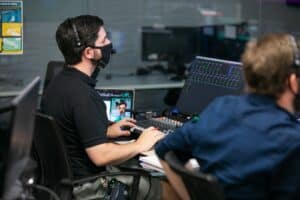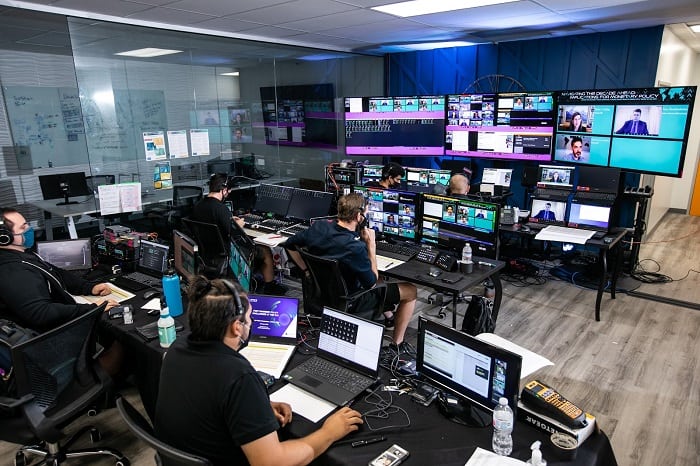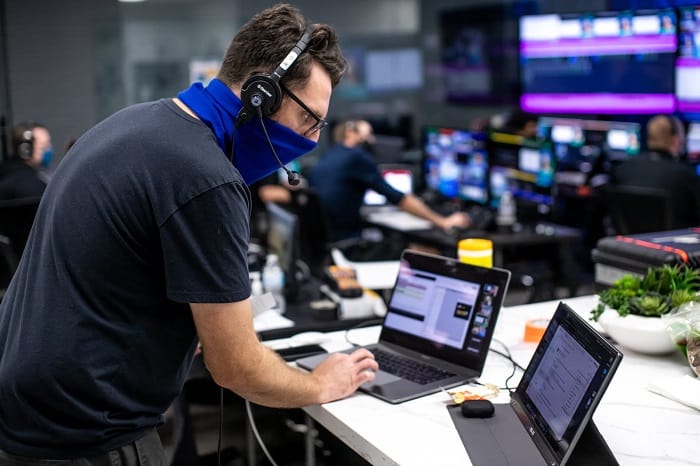On August 27th, 2020, Chair of the Federal Reserve Jerome Powell delivered a powerful keynote speech on the current state of the Federal Reserve.
Due to Covid-19 restrictions, this typically live event had to be conducted entirely virtually. Thanks to our virtual event production company, this new form wasn’t a handicap—it was an opportunity. Over 300,000 live viewers were able to experience his impactful words without a hitch.
Here’s how we did it…
The Shifting World of Events in 2020
The recent events of this year have impacted almost every area of our daily lives in unprecedented ways—and the events arena is no exception.
With large-scale gatherings becoming an impossibility for the near (and possibly, distant) future, event planners have had to rapidly adapt, suddenly dealing with both physical limitations and expansive digital demand.
With these newfound requirements and challenges, many may wonder how virtual events can possibly have the same impact as their in-person predecessors.
This article intends to pull the curtain back on how to run a virtual event effectively (and memorably) over the course of these three phases:
- Pre-production: Asking the right AV questions
- Acquiring the right tools
- Building the right team
Stage 1: Pre-Production – How to Ask the Right Questions

- Pre-Production
Virtual events should not be underestimated. Because there are fewer opportunities to troubleshoot and improvise during the actual event, pre-production needs to be watertight and thorough.
In fact, a successful virtual event requires three to four times more pre-production than in-person events. That’s because if every minute and every second of the show isn’t planned, you’re already behind.
Virtual event planners are like master chess players—they always have to stay five steps ahead. And preparing so intensively is all about asking yourself the right questions long before you begin making purchases and securing presenters.
Here are just a few you should be asking your team:
- Is this session truly live, or are bits pre-recorded?
- What resources (equipment, software, labor, etc.) are being utilized to produce the show right now?
- What technology and subcontracted companies are being used to support this event?
- How many tech staff are working to produce this session? And how many are there to manage the entire online conference?
- How will we accommodate potential attendees and presenters in various time zones during our live-streamed portions?
As for any event, you have to plan for the worst, even in the virtual realm. If you lack experience in virtual event planning, you might not know exactly what to expect from the worst-case scenario.
Here are some mishaps and disruptions unique to virtual gatherings that you should prepare for:
- “Zoom-bombing” – If you’re using any streaming platform, you may encounter a phenomenon known as “zoom-bombing,” wherein malicious strangers enter your online event uninvited and attempt to disrupt it. Be sure to set up waiting rooms, custom virtual meeting room invitations, or passwords to avoid this unseemly encounter. Or better yet, don’t rely on third party video conferencing software, use a platform that has it included.
- Network Failure – Ensure that you have a back-up plan and technicians on deck to handle any network failures or slow-downs during your event. Check with the venue beforehand to see if they include any of these accommodations in their contract.
- Power Outages – Make sure your command center is prepared to handle any power outages or server failures that could affect your streaming, control, or audiovisual abilities. These precautions could include having specialized personnel on-call or acquiring a back-up generator.
- Waiting Room Limbo – If you set up waiting rooms for your virtual meetings, be sure you have a system in place or a person on call to continually screen and admit attendees into the virtual meeting. Nothing is worse than being a paid online conference-goer and getting stuck in a blank virtual waiting room.
- Streaming Lag and Delay – Virtual events typically operate with a 15-30 second delay to account for transitional time, blunders, and technical difficulties. However, that presents a problem for real-time audience engagement and interaction. Make sure you have a system in place to queue up audience questions and transition them seamlessly into the program.
Stage 2: Using the Right Tools and Tech

- Using the right tools and tech
While it may seem that the technological demand for virtual events is limited to video streaming and a good internet connection, the reality is far more complicated. Not only do virtual events require similar equipment to onsite ones, but they also require tech tools unique to the medium.
Here are some of the tech tools and equipment you’ll need to pull off a great virtual event without any bumps in the digital road:
- Robust computers and servers – When it comes to virtual events, timing is everything. Your production team will spend the event in a dedicated command center, where they’ll need adequate computational power to run the show and power streaming to thousands of attendees.
- Command display software – On a similar note, you’ll need a program to consolidate various online event views across the same computers and servers. At Vario, we use Bitfocus Companion to control all displays.
- Broadcast mixing software – To manage the many inputs, destinations, and audio tracks that take place simultaneously during your broadcast, take advantage of a specialty mixing software like vMix.
- Audiovisual equipment – Make sure your video quality is stellar with top of the line video and recording equipment.
- Live-streaming software – You’ll need to use a live-streaming software that can support hundreds or even thousands of viewers. Try vMix, Webex, or Zoom to broadcast remote presenters.
- Virtual conference platforms – For further real-time interaction, use a proprietary virtual conference platform site or live-streaming platforms with chat features like YouTube, Twitch, or more. You can also send a rebroadcast signal to other networks, like major news outlets, to share live with their respective networks.
- Robust network – You’ll be streaming out of a WAN (wide area network) and therefore need to include redundancies in how you broadcast your event. At Vario, we stream out of two redundant fiber lines to ensure we’re always connected.
- An event app – Don’t limit your communications platform to your event website or streaming service. With an app, your potential attendees can network, pick-and-choose their event schedule, and submit questions through a convenient portal. This tool is especially necessary if you’re hosting meetings or presentations that overlap.
Preparing the Venue
Just because your attendees aren’t there in person doesn’t mean you don’t have to secure a venue.
Even if you’re fully pre-recording all of your presentations, you still need to scout locations for the various demonstrations, seminars, and panels you’ll be streaming to your target audience.
These require the same care that you would apply to an in-person presentation, if not more:
- Audio should be crisp and set at an appropriate volume.
- Image quality should be high-definition and color-balanced.
- The lighting should be flattering to both the speaker and the venue.
- Take care to dress the stage, podium, and room—even if minimally—with a thoughtful aesthetic that aligns with your brand image and theme.
While your target audience may not be able to touch or smell the venue, they can still see it. Make sure it’s something worth looking at (and paying money for).
Stage 3: Building the right team

- Building the right team
Putting on a successful virtual event without a hitch takes a specialized and experienced team. While some roles may overlap with those of in-person events, their responsibilities and tasks are not all the same.
When it comes to building the perfect staff for your event, you cannot treat it like you would an in-person one. With this unique medium comes unique demands for personnel.
Here are some of the roles you’ll need to fill that you may not have thought of:
- A show caller that runs the show behind the scenes
- A virtual emcee that hosts the event and helps transition presenters smoothly
- A video switch operator that mixes the entire show
- An audio mixer that handles all the microphones, sound transitions, and muting
- An onboarder that handles the event’s various presenters
- An attendee support manager to field participant questions and concerns on the day of
- A technical director that runs the moment-to-moment of the show
- A video broadcast engineer to maintain the strength and clarity of your images in real-time
Let Vario Take Your Event Virtual
Vario knows how to take your vision and make it virtual. We honor and embrace your ideas, and we love tackling the unique challenges that come with every new event.
For us, the shift to virtual isn’t a handicap, it’s a new puzzle—and one that we can’t wait to solve with you. Let our event production management team connect the dots between the audiovisual, entertainment, and technical aspects of your event.
Much like our event with the Federal Reserve, our team will connect with yours to ensure unparalleled hands-on collaboration and guidance. There’s a reason why more than 300,000 remote viewers were able to experience the power of Chairman Powell’s message.
That reason was Vario. Have a look at a little “Behind the Scenes” footage video:
Contact us today to see how we can create a thrilling, memorable, and customized virtual experience for your next corporate gathering.
Sources:
- Impact. What a best-in-class virtual events team looks like (recommended roles + examples). https://www.impactbnd.com/blog/virtual-event-team
- SocialTables. 10 Must-Have Virtual Event Technology Tools. https://www.socialtables.com/blog/event-technology/virtual-event-technology-tools/







